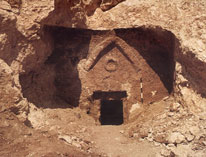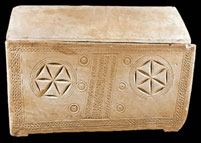|
Film Claims Jesus’ Burial Site Found
Compiled By S. E. Ray
On March 6, 2007, four million viewers watched the Discovery Channel deliver the television documentary "The Jesus Family Tomb" while the companion book rocketed to sixth place on the New York Times nonfiction best-seller list. The broadcast along with the book tries to prove that located in a suburb called East Talpiot, is the family plot of the religious figure Jesus Christ. Managed by an Emmy award-winning documentary filmmaker Simcha Jacobovici, and produced by "Titanic" director James Cameron, the movie is an entertaining and engaging narrative about the 1980 discovery of a first-century Jewish burial cave and 10 ossuaries (bone box coffins).
With the help of reputable
archeologists, historians, DNA experts, robot-camera technicians,
epigraphers and a CSI expert from New York's Long Island,
Jacobovici assembles a case in which he says proves that the bones
of these famous biblical figures were once entombed in this cave.
James Charlesworth of the Princeton Theological Seminary consulted
with Jacobovici and expressed: "A very good claim could be made
that this was Jesus' clan." Not afraid of being unpopular,
Jacobovici with Cameron's help secured Discovery Channel's backing
and a $3.5 million budget. If it can proven, the discovery would
discredit the message of Christendom and require a radically
revised theology.
Six of the ten coffins that
Jacobovici found so powerful, had inscribed: Jesus, son of Joseph;
Maria; Mariamene; Matthew; Judah son of Jesua (Jesus’ son - the
filmmakers claim); and Jose, a diminutive of Joseph. Although the
cave was discovered nearly 30 years ago and the casket
inscriptions decoded ten years ago, the filmmakers are the first
to establish that the cave was in fact the burial site of Jesus
and his family. The official report written by the archeologist
Amos Kloner found nothing remarkable in the discovery. The cave,
it said, was probably in use by three or four generations of Jews
from the beginning of the Common Era. The names on the boxes were
popular in the first century (25 percent of women in Jerusalem,
for example, were called Miriam or a derivative). “The use of
the names of the members of the biblical family,” Prof. Amos
Kloner who oversaw the archeological work at the Talpiot tomb
said, "Is just a coincidence.
Kloner was asked about his
opinion on the claims made by the documentary; he said "It
makes a great story for a TV film” the professor reportedly
told The Jerusalem Post, “but it's completely impossible. It's
nonsense. There is no likelihood that Jesus and his relatives had
a family tomb. They were a poor Galilee family with no ties in
Jerusalem. The Talpiot tomb belonged to a middle class family from
the 1st century CE." He went on to say "The name "Jesus son
of Joseph" has been found on three or four ossuaries. These are
common names... Give me scientific evidence, and I'll grapple with
it. But this is manufactured."
The film and book take a Gnostic
position and suggest that New Testament's Mary Magdalene was
buried in the tomb, that she and Jesus were married, and that an
ossuary labeled "Judah son of Jesus" belonged to their son.
Stephen Pfann, a textual scholar and paleographer at the
University of the Holy Land in Jerusalem, said he has released a
paper claiming the documentary was mistaken or fudging at best.
The inscription, Pfann said, is made up of two names inscribed by
two different hands: the first, "Mariame," was inscribed in a
formal Greek script, and later, when the bones of another woman
were added to the box, another scribe using a different cursive
script added the words "kai Mara," meaning "and Mara." Mara is a
different form of the name Martha. According to Pfann's reading,
the ossuary houses the bones of two women, "Mary and Martha." |


